Final report for GNE20-236
Project Information
Drawbacks of excessive pesticide usage in cantaloupe have created a demand for alternative pest control strategies that can reduce producers’ reliance on chemical inputs. The economic burden of growing cucurbits such as cantaloupe can be considerable due to the cost of frequently applied chemicals to protect cucurbits with low pest tolerance. Further, chemical sprays can have a negative impact on natural enemies inhabiting cucurbit fields and consequently cause secondary pest outbreaks. Interplanting cash crops with cover crops, also known as companion planting, has been used for centuries to improve soil quality and suppress weeds. However, interplanting a live cover crop (living mulch) into a cucurbit crop can be used to also help manage insect pests and diseases that they vector. Recent research has shown that interplanting a red clover living mulch into cucumber plantings can be an effective strategy to reduce insect pest and increase natural enemy populations without negatively impacting crop yield. This is a promising finding for other crops in the Cucurbitaceae family that share similar insect pests. The aim of this study was to determine if similar benefits can be conferred to a cantaloupe system. Specifically, the objective was to determine whether interplanting cantaloupe into two perennial living mulches (i.e., alsike clover or Virginia wildrye) systems that are structurally dissimilar can be used to reduce insect pest and increase natural enemy populations in cantaloupe. While this study doesn't provide definitive evidence supporting or disproving the potential value of living mulches in cantaloupe systems, the study highlights the significance of investigating how different living mulch and cash crops systems in behave.
The overall objective was to investigate and disseminate an alternative tactic for managing insect pests in cantaloupe plantings. Specific study objectives are as follows:
- Compare the impact of a monoculture cantaloupe treatment with two additional treatments: 1) cantaloupe interplanted into a perennial bunch grass (Virginia wildrye, Elymus virginicus) and 2) interplanted into a perennial legume (alsike clover, Trifolium hybridum) on herbivore abundance,
- Compare treatment impact on the abundance of natural enemies,
- Determine treatment impact on yield and fruit quality, and
- Determine the potential of different treatments to serve as overwintering refuge for natural enemies
The purpose of this project was to investigate living mulches in cantaloupe plantings as a sustainable alternative to insecticides for managing insect pests. Insect pests pose a challenge for Northeast cantaloupe growers; and if left unmanaged, can cause significant yield reductions and lost revenue. However, using an intensive chemical regimen for their mitigation can contribute to environmental and human health problems (Geiger et al., 2010; Relyea, 2016; Weisenburger, 1993). For example, a common pest mitigation practice used in cantaloupe is the application of systemic neonicotinoids to protect seedlings which is typically the most vulnerable stage (CMCC, 2003). Unfortunately, these products have received public scrutiny worldwide because of their potential contribution to pollinator decline (Van der Sluijs et al., 2013). Further, the high susceptibility of cantaloupe to pest damage and insect vectored diseases contributes to many growers administering prophylactic sprays. Cantaloupe is the second most susceptible cucurbit crop to insect damage (ATTRA, 2008), and tolerance to insect feeding damage is low in cantaloupe due to the threat of bacterial wilt. As such, some extension programs suggest foliar application of pyrethroids when only one cucumber beetle per plant is observed (Brust & Foster, 1999). In the year 2000, insecticides were used on 74% of US cantaloupe crops. Most treatments were applied to plants after crop emergence to protect them after fruit-set (CMCC, 2003). Concerns for cucumber beetles alone cause some growers to apply pesticides as many as seven times over a single season to prevent significant lost (Brust & Foster, 1999).
In recent studies, performed in our lab, crops in the Cucurbitaceae family (e.g., zucchini and cucumber) experienced a significant reduction in insect pest and increase in natural enemy abundance when interplanted with a living mulch (Hinds & Hooks, 2013; Kahl et al. 2019). Increasing the vegetational diversity within a crop field by adding multiple plant species can confer associational resistance to cash crops. Associational resistance is when neighboring plant species decrease the likelihood that vulnerable plants will be discovered or exploited by insect herbivores. This phenomenon can be explained by two non-exclusive hypotheses: 1) The resource concentration hypothesis states that increased plant diversity makes it more difficult for herbivores to detect their host plants, and 2) the natural enemy hypothesis suggest that natural enemies can more effectively colonize and reduce herbivores on crop plants in more vegetationally diverse environments due to increased structural diversity and the presence of alternate prey (Barbosa et al., 2009). This research advances our knowledge on living mulch usage by investigating responses of pests and natural enemies to their presence in cantaloupe plantings. In this study I compared the effect of two perennial living mulches with structural differences on populations of pests, beneficials, over wintering natural enemies, and crop yield. Past studies have shown that leguminous cover crops (clover) can be used to reduce pest colonization and tenure time and that perennial grasses can serve as refugia for overwintering natural enemies (Bowers, Toews, Liu, & Schmidt, 2020).
Research
Experimental layout and design
To fulfil my objectives, field trials were conducted at the University of Maryland’s Central Maryland Research and Education Center in Upper Marlboro, MD. The experiment consisted of three treatments: 1) cantaloupe interplanted into alsike clover living mulch, 2) cantaloupe interplanted into Virginia wildrye living mulch, and 3) monoculture cantaloupe (grown in bare-ground). The experiment was replicated four times and arranged in randomized complete block design. Each plot measured 12.1 m by 12.1 m and was separated by 7.6 m alleys. Within each plot there were eight rows of cantaloupe with plants spaced 91 cm apart within rows and a between row spacing of 1 m. Each row consisted of 13 cantaloupe plants each (Figure 1).
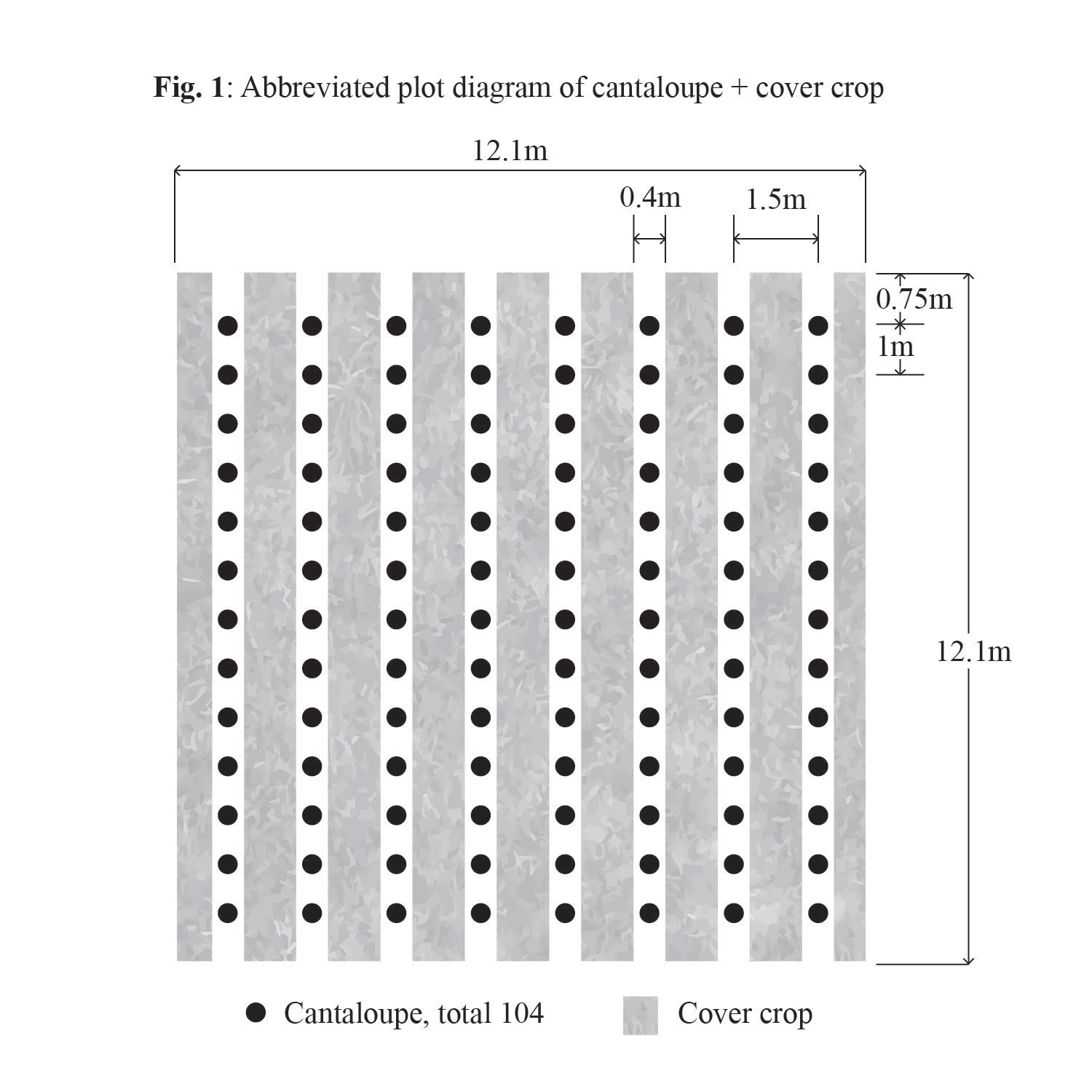
Alsike clover and Virginia wildrye were seeded in their respective treatment plots with a no-till drill in late September 2019 for the 2020 field season, as well as September 2020 for the 2021 field season. Monoculture plots were left fallow over the winter. Sugar cube was the variety of cantaloupe used, partially due to its high level of disease resistance. Cantaloupe seedlings were grown out in a greenhouse for two weeks before they were transplanted into the field on June 30th. In 2020, one week before the cantaloupe was transplanted, monoculture plots were rotary tilled, and living mulch treatment plots were mowed with a rotary mower to reduce potential early season competition with the cantaloupe and strip tilled approximately 38 cm wide where cantaloupe rows were established. The remaining interrow areas consisted of the alsike clover of Virginia wildrye. In 2021, the seeding rate for the living mulches was increased by 50% and rotary tilling occurred a month ahead of transplanting to facilitate the "stale seedbed technique" in order to better suppress weeds over the previous year. The stale seedbed technique involves allowing weeds to flush over a period of time and then killing them all at once with glyphosate in order reduce the potential for subsequent flushes of weeds.
Objective 1: Compare treatment impact on insect pest (herbivore) abundance
Several monitoring techniques were used to quantify herbivore abundance. The primary monitoring techniques included visual counts on the cantaloupe foliage and the deployment of yellow sticky cards. For visual counts, a square meter quadrat was randomly placed in each interior cantaloupe row with a minimum of one meter from the border. All arthropods encountered on the foliage or visible on the ground within the quadrat were field-identified to the lowest taxonomic level possible and recorded. Insect herbivores that were expected to colonize the cantaloupe included striped and spotted cucumber beetles, squash bugs, and melon and green peach aphids. Visual counts were conducted every week initiating two weeks after planting up until the beginning of harvest. Visual counts were always conducted in the mornings close to the same time and the order of reps was randomized to maintain observational integrity.
Yellow sticky cards were used mainly for detecting aerial arthropods at or above the cantaloupe canopy. Two cards were deployed in the center of each plot, one in the inter-row and intra-row areas areas. Cards were held in place on fiberglass poles with a pair of clothes pins at canopy height. Sticky cards were deployed two weeks after planting and remained in place for one week prior to collection. Cards were deployed on 3 occasions spaced 3 weeks apart to provide an image of insect abundances in the early, middle, and late stages of the cantaloupe development. Sticky card specimens were counted and identified to the lowest taxa possible. An advantage of using sticky cards is that they can remain in the field for an extended period of time and continue to capture insects throughout the day and evening. Once collected, cards were placed in zip-tied bags and stored in the lab freezer until their contents could be identified using a stereomicroscope.
Objective 2: Compare treatment impact on the abundance of natural enemies
Natural enemies were counted along with herbivores during sampling tasks described in objective 1. However, in addition to foliar and sticky card counts, pitfall traps were be used to quantify the activity density of ground dwelling predators, including wolf spiders, rove beetles and ground beetles. Two pitfall traps were installed in each plot, one in the inter-row and intra-row areas. Pitfall traps consisted of two nested plastic cups placed flush with the surface of the ground. The top cup was removable and partially filled with propylene glycol as the trapping/killing agent. A 30x30 cm square black plastic cover supported by three large screws was placed over each trap with two to three centimeters of clearance to prevent traps from being flooded by rain or disturbed by wildlife. Pitfall traps were deployed and retrieved on the same dates as sticky cards. Once trap contents were retrieved, samples were brought back to the lab and vacuum filtered to separate them from the propylene glycol. Specimens were then transferred to a 70% ethanol solution to be preserved until they could be identified under a stereomicroscope.
Analysis (Objective 1 and 2)
Important or frequently appearing arthropod taxa observed across the sampling period are being analyzed. Visual counts were converted into number per square meter densities. All quadrats within a plot were averaged to represent the estimated density of arthropods for that entire plot for the given sampling period. Densities of notable arthropod species were compared over time between treatments using a linear mixed-effect model, and where treatment effects were detected pairwise comparisons of each treatment on each date were conducted to determine where the treatment effects were arising from. Results of visual counts and yellow sticky cards were also compared with action thresholds of an average of one cucumber beetle per plant or 15 beetles per sticky card. If there is no effect of pitfall trap location (intra vs inter-row) content of both traps will be pooled otherwise comparison will be made by trap location.
Objective 3: Determine treatment impact on yield and fruit quality
During each harvesting event, the total number and weight of harvestable and marketable fruit more than 4ft from the plot border was measured. Harvested fruit was evaluated by quantifiable measures of fruit quality by sampling 4 fruit of equal ripeness from each experimental plot during a single harvesting event. These measured characteristics included weight, polar and equatorial diameter, soluble solid (sugar) content, titratable acidity, skin and flesh hue, chroma and lightness, as well as texture characteristics including firmness, adhesiveness, springiness, cohesiveness, chewiness, and resilience. Treatment effects were checked for using a one-way ANOVA, and when treatment effects were detected a Tukey-Kramer test was completed to determine which treatments were statistically unique from each other.
Objective 4: Determine the potential of different treatments to serve as overwintering refugia for natural enemies
After harvest, the living mulch remained undisturbed in the plots through the fall and winter into 2021. In March 2021, two 60cm x 60cm soil emergence traps (cages) were left in place in two randomly selected interrow areas in each plot. Trapping will lasted 10 weeks up through May. Collection jars in the top of each emergence cage were partially filled with propylene glycol. Trap contents were collected and replaced weekly. After collection, contents were filtered and transferred to a 70% ethanol solution for storage until they could be identified to the lowest possible taxa. Arthropod counts will be converted into number per 0.36 m2 (area covered by the trap). Traps within the same plots will have their weekly values averaged. Weekly insect trap content for each treatment will be compared using a linear mixed effect model and total seasonal emergence will be compared between treatments.
Research results and discussion:
Objective 1: Compare treatment impact on insect pest (herbivore) abundance
Visual counts- In 2020 and 2021 there was no treatment differences in striped cucumber beetle numbers from foliar counts (Table 1). Striped cucumber beetles remained low throughout the study and did not exceed one beetle per square meter. Comparably, aphid counts were similar among treatments and remained lower than one individual per square meter.
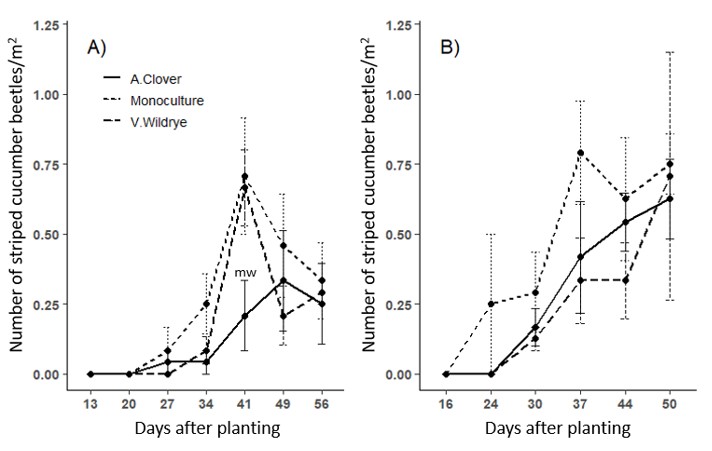
Yellow Sticky Cards- Regarding significant pest groups, numbers of striped cucumber beetle detected on yellow sticky cards were similar among treatments and did not exceed the 15-beetle per card action threshold during each sampling period. However, unlike foliar counts, differences were detected among treatments in aphid numbers on sticky cards. In 2020, differences occurred during mid- (39 DAP, χ2 =11.17, df =2, P=0.004) and late-season (56 DAP, χ2 =8.37, df =2, P=0.025). During both periods, aphid counts were higher in clover than wildrye (P<0.047) (Table 1). In 2021, a significant treatment effect was detected during all three stages (16 DAP: P=0.002, 37 DAP: P=0.042 and 57 DAP: P=0.018). At 16 DAP, aphid numbers were higher in monoculture than wildrye (P=0.018) and at 37 DAP numbers were marginally higher in clover than wildrye (P=0.088) and at 57 DAP, aphid numbers were marginally higher in clover (P=0.075) and wildrye (P=0.095) than monoculture (Figure 2).
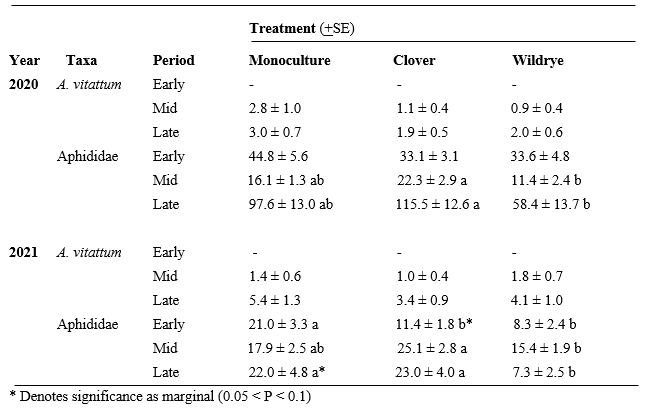
On the guild level, a total of 1,002 leaf chewing insects across six families were captured during the study. The majority were species of leaf beetles (Chrysomelidae 81%) followed by weevils (Curculionidae 16%) which collectively accounted for 97% of leaf chewing insects captured. Most chrysomelid captured were flea beetles (tribe: Alticini 61%), followed by striped cucumber beetles (Acalymma vittatum 23%) and spotted cucumber beetles (Diabrotica undecimpunctata 8%). The leaf-chewing guild was mostly numerically similar among treatments during both years. An exception occurred in 2020, during the early plant stage (15 DAP: χ2 =11.87, df =2, P=0.002) in which numbers were greater in monoculture than wildrye (P=0.022).
A total of 35,393 leaf piercers were captured across 20 families. The most abundant leaf piercers were leafhoppers (Cicadellidae 51%), non-predatory thrips (order: Thysanoptera 29%), and aphids (Aphididae 13%) which collectively accounted for 93% of leaf piercers captured. In 2020, there was a treatment effect on numbers of leaf piercing herbivores during all three periods (15 DAP: χ2 =24.91, df =2, P<0.0001, 39 DAP: χ2 =8.68, df =2, P=0.013, 56 DAP: χ2 =16.75, df =2, P=0.0002). There were greater numbers found in clover than monoculture during early (P=0.007) and late (P=0.047) season and numbers were higher in clover than wildrye during all three periods (early: P=0.004, mid: P=0.04 and late: P=0.008; Table 2). In 2021, difference existed during early (16 DAP: χ2 =31.63, df =2, P<0.0001) and late season (57 DAP: χ2 =10.25, df =2, P=0.006). Numbers were higher in clover than monoculture during early season (P=0.001) and in clover than wildrye during early (P=0.005) and late season (P=0.028) (Figure 3).

Objective 2: Compare treatment impact on the abundance of natural enemies
Visual counts- There was a significant treatment effect on spiders in 2020 (χ2 =6.92, df =2, P=0.031) and 2021 (χ2 =26.13, df =2, P<0.0001), and a significant date by treatment interaction (χ2 =46.9, df =12, P<0.0001; 2020) and (χ2 =58.69, df =10, P<0.0001; 2021). In 2020, at 34 (P=0.02) and 56 (P<0.0001) days after planting (DAP) more spiders were found in clover than wildrye. Also, at 34 DAP more were found in monoculture than wildrye (P=0.0007). In 2021, more spiders were found in clover than monoculture at 23, 30, 37 and 44 DAP (P<0.042). Spider counts were also greater in clover than wildrye at 30, 37 and 44 DAP (P<0.0003) and wildrye than monoculture at 30 DAP (P=0.019) (Figure 4).
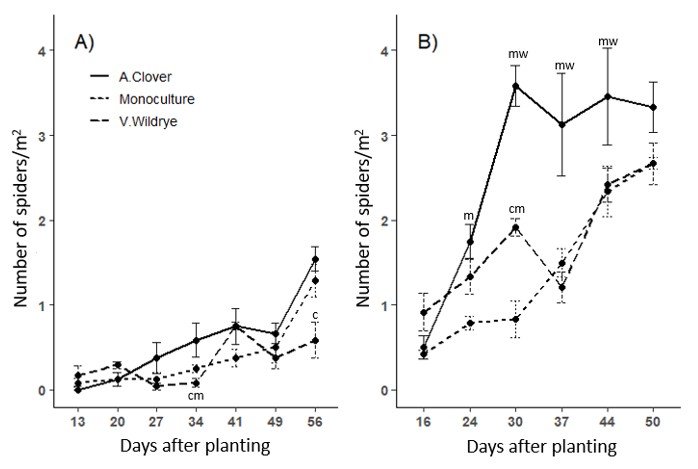
Figure 4: Mean number of spiders (Araneae) (+ SE) per m2 found within the cantaloupe foliage during the 2020 (A) and 2021 (B) field seasons. A c, m, or w indicate numbers are significantly different (P < 0.05) from clover, monoculture or wildrye, respectively.
Yellow Sticky Cards- A total of 10,527 parasitic wasps were captured across 28 families. The most common parasitic wasp families captured were Platygastridae (25%), Mymaridae (21%), Trichogrammatidae (14%), Encyrtidae (11%), Ceraphronidae (10%), Figitidae (7%) and Aphelinidae (5%) which collectively accounted for 95% of specimen captured on yellow sticky cards. In 2020, there was a significant treatment effect in the number of parasitic wasps captured during early-season (16 DAP, χ2 =8.33, df =2, P=0.016). During this period, counts were marginally higher in clover than monoculture plots (P=0.054; Table 2). In 2021, there was a significant treatment effect on parasitoid numbers during early (16 DAP: χ2 =19.98, df =2, P<0.0001) and mid-season (37 DAP: χ2 =10.68, df =2, P=0.005). During early season, parasitoid numbers were greater in clover than monoculture (P=0.008) and Wildrye (P=0.011). However, during mid-season numbers were higher in monoculture than clover (P=0.042) and marginally higher in monoculture than wildrye (P=0.053; Table 3).
A total of 815 chewing predators across 13 families were captured during the study. The most common were ladybeetles (Coccinelidae 39%), rove beetles (Staphypinidae 28%), and ants (Formicidae 20%). These three families accounted for 87% of chewing predators captured. Differences among chewing predators only occurred in 2020 during mid (χ2 =13.52, df =2, P=0.001) and late (χ2 =6.46, df =2, P=0.04) season. In mid-season, there were more found in monoculture than clover (P=0.014). Also, during this period, numbers were marginally higher in monoculture than wildrye (P=0.091). In late season, numbers were marginally higher in clover than wildrye (P=0.077).
A total of 2,375 piercing predators were captured across 10 families during the study. The most abundant were minute pirate bugs (Anthocoridae, genus: Orius 44%), dance flies (Hybotidae 32%), stilt-legged flies (Dolichopodidae 12%) and big-eyed bugs (Geocoridae, genus: Geocoris 10%). These families accounted for 98% of piercing predators captured. In 2020, differences in piercing predators were found during early season (15 DAP: χ2 =23.44, df =2, P<0.0001). During this period, more were found in monoculture than wildrye (P=0.005) and wildrye than clover (P=0.007) (Table 2). In 2021, differences among treatments were found at all growth stages (16 DAP: χ2 =16.356, df =2, P<0.0003; day 37: χ2 =8.1, df =2, P<0.018; and day 57: χ2 =9.47, df =2, P<0.009). During early season numbers were higher in clover compared with monoculture (P=0.012) and wildrye (P=0.022) (Figure 5).
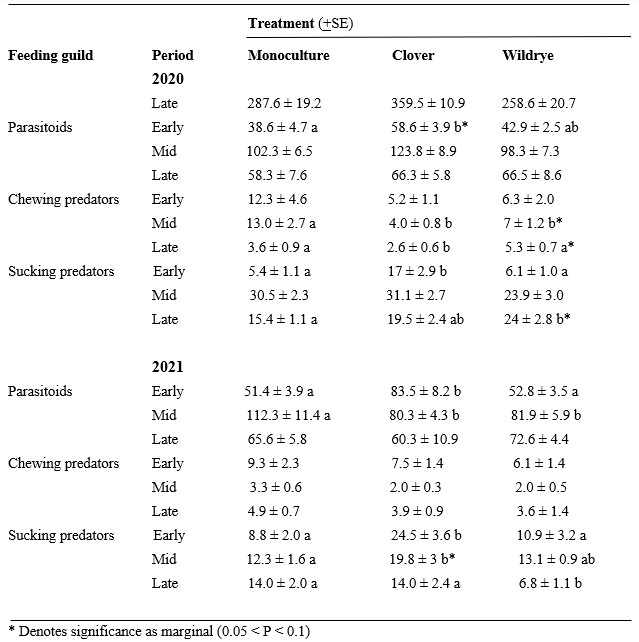
Pitfall Traps - In 2020, there were no treatment differences in wolf spiders, ground beetles, rove beetles or various feeding guild captures in pitfall traps (Table 4). In 2021, a significant treatment effect on ground beetle numbers was detected during the early stage (day 16: χ2 =10.37, df =2, P<0.006). During this period, their numbers were higher in monoculture than wildrye (P=0.039). Treatment difference among rove beetles were detected during early (day 16: χ2 =9.23, df =2, P<0.001) and mid-season (day 37: χ2 =9.37, df =2, P=0.009). During both periods, more rove beetles were found in clover than monoculture (day 16: P=0.038, day 37: P=0.033). Wolf spider numbers were higher in clover than wildrye during early season (day 16: χ2 =13.81, df =2, P=0.001). Detritivores (which in this study includes fungivores) were the only feeding guild that differed among treatments. A total of 2,889 detritivores representing 36 families were captured. Most were field crickets (Gryllidae 63%) followed by scuttle flies (Phoridae 9%) and sap beetles (Nitidulidae 8%). These families accounted for 80% of the detritivores captured. In 2020, (day 16: χ2 =18.47, df =2, P<0.0001) significantly more detritivores were captured in clover compared with monoculture and wildrye (P=0.012) (Figure 6).
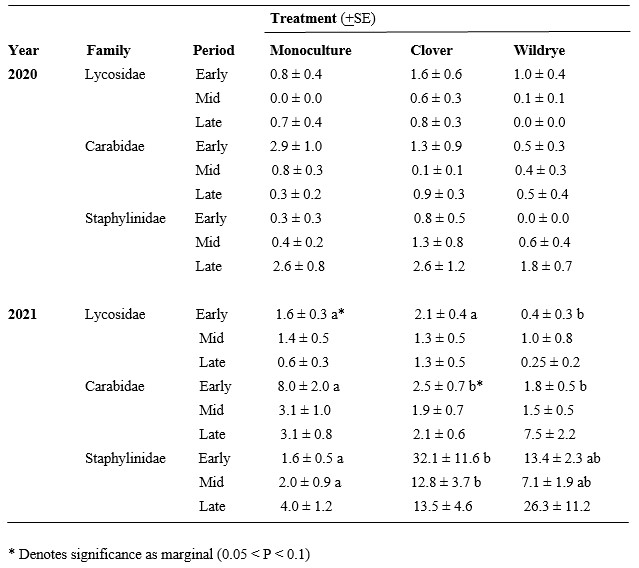
Objective 3: Determine treatment impact on yield and fruit quality
Cantaloupe Yield - Treatment effect on fruit yield were detected during both years (2020: F-value=11.07, P=0.004, 2021; F-value=81.69, P<0.0001; Figure 7). In 2020, yield was 65% higher in monoculture than wildrye (P=0.003). In 2021, yield in monoculture was 96 and 87% greater than clover and wildrye, respectively (P<0.0001).
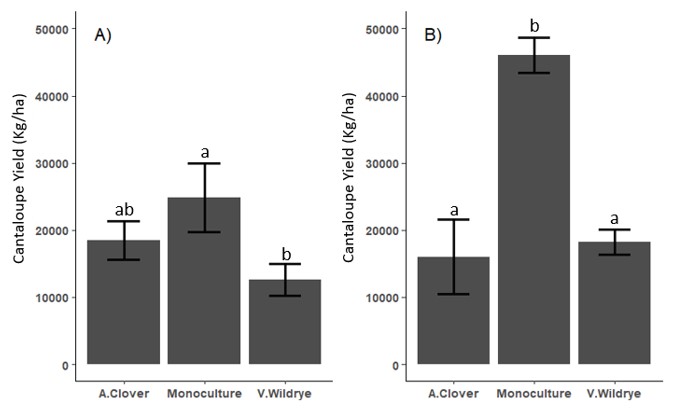
Cantaloupe Quality - In 2020, there was no treatment effect on the average weight, soluble solid content, or polar or equatorial diameter of fruit. However, treatment differences were detected in firmness (F-value=6.5, P=0.033) and stiffness (F-value=17.98, P<0.0001). Fruit harvested from wildrye were firmer than fruit in monoculture (P=0.003) and fruits in monoculture were stiffer that those harvested in clover (P=0.0004) and wildrye (P<0.0001). Fruit flesh hue angle was higher in the monoculture than clover (P=0.0203; Figure 8).
In 2021, more differences were detected among fruit quality parameters. Differences between treatments were observed for weight (F-value=15.12, P<0.0001), polar circumference (F-value=7.82, P=0.001) and equatorial circumference (F-value=4.34, P=0.012). In monoculture, fruits were 22 and 30% heavier than in clover and wildrye, respectively. Their polar circumference in monoculture was 6.8 and 8.4% greater than clover and wildrye, respectively and their equatorial circumference in monoculture was 5.5 and 5.4% greater than clover and wildrye, respectively. Stiffness was the only texture metric that differed among treatments (F-value=4.13, P=0.023). Fruits in monoculture were stiffer than those in wildrye (P=0.033).
In 2021, differences existed between skin chroma (F-value=3.98, P=0.020), skin hue angle (F-value= 3.13, P=0.046), flesh chroma (F-value=9.9, P<0.0001), and flesh hue angle (F-value=5.73, P=0.004). Skin hue angle (P=0.038), flesh hue angle (P=0.007), and flesh chroma (P=0.0005) were higher in clover than monoculture. Fruit in wildrye contained a higher skin chroma (P=0.017), flesh chroma (P=0.0005) and flesh hue angle (P=0.016) than monoculture (Figure 8).
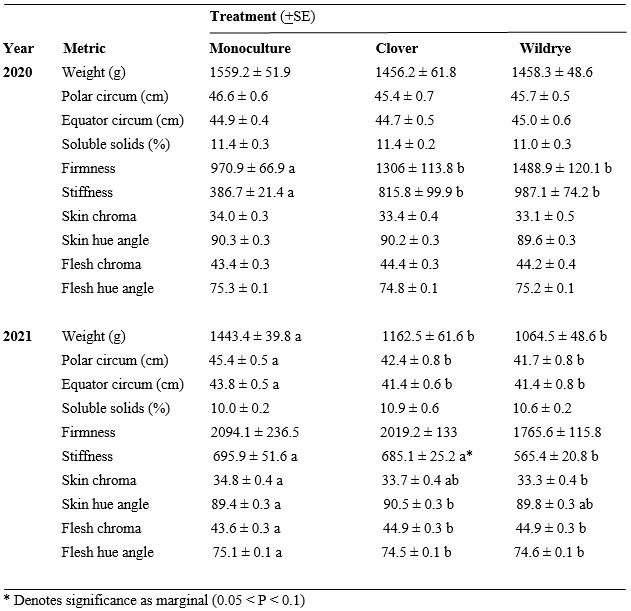
Objective 4: Determine the potential of different treatments to serve as overwintering refugia for natural enemies
There currently isn't any data related to the overwintering communities of natural enemies in the plots, but overwintering traps were be deployed in March and samples were collected over a two month period. Sample identification will be carried out and the analysis of the abundance and density of notable taxa will be measured and analyzed using similar methods to the insect surveys conducted via foliar counts and sticky and pitfall trap captures over the past two summers.
Discussion
The goal of this study was to determine if interplanting a living mulch with cantaloupe would result in fewer insect herbivore pests and greater numbers of beneficial arthropods; and to determine the response of arthropods in two structurally dissimilar living mulches. It was hypothesized that interplanting a living mulch into cantaloupe would result in a reduction in specialist cantaloupe herbivores and increased abundance of natural enemies. Though, some arthropods and feeding guilds conformed to this supposition, several had a neutral, inconsistent or aberrant response to the living mulch’s presence and responded differently according to living mulch type. The striped cucumber beetle, a cucurbit specialist herbivore, appeared to be unaffected by the living mulches and consequently were found in similar numbers among cantaloupe habitats on most sampling dates. During several periods greater number of leaf piercing herbivores including aphids, a major cantaloupe pest, were found on yellow sticky cards in cantaloupe interplanted with clover than wildrye and/or monoculture. However, no differences were detected among herbivore guilds within the cantaloupe foliage. With respect to natural enemies, spiders were one of the few natural enemy groups frequently influenced by the living mulch. They were found in greater abundance during visual counts in cantaloupe interplanted with clover than wildrye or monoculture plantings during several sampling periods. Other natural enemy guilds such as parasitic wasps and piercing predators were inconsistently influenced by living mulch types.
Striped cucumber beetle numbers were similar among treatments on most sampling dates with the exception of a single sampling date in which beetles were less abundant in clover compared to other treatments. These results contrast past findings in other cucurbit systems in Maryland in which cucumber (Cucumis sativus) and zucchini (Cucurbita pepo) when interplanted with a red clover (Trifolium pratense) and sunn hemp (Crotalaria juncea) living mulch, respectively, resulted in reduced striped cucumber beetle numbers (Kahl et al. 2019; Hinds and Hooks 2013). In addition, Bach (1980) demonstrated in Michigan that striped cucumber beetle abundances were 10-30 times higher in monoculture cucumber compared to a polyculture system which included corn (Zea mays) and broccoli (Brassica oleracea). Bach (1980) determined that host plant diversity was a primary driver of differences in their abundance. Similarly, Cline et al., (2008) found reduced striped cucumber beetle numbers in watermelon (Citrullus lanatus) and cantaloupe (Cucumis melo) when grown with multiple companion plants. During year 1, watermelon was grown with Radish (Raphanus sativus), tansy (Tanacetum vulgare) and nasturtium (Tropaeolum spp) to repel cucumber beetles, or buckwheat (Fagopyrum esculentum), cowpeas (Vigna unguiculata) and sweet clover (Melilotus officinalis) to attract natural enemies. In year 2, cantaloupe was grown with buckwheat and radish.
Despite no treatment effect in the current study, striped cucumber beetle populations were consistently below the economic threshold level (Brust, 1999) in all treatments. Relative to this, the earliest foliar detections of striped cucumber beetles were at 27 DAP in 2020, and 24 DAP in 2021 which is near the end of the 30 day period in which cantaloupe is considered most vulnerable to yield reduction due to insect caused damage (CMCC, 2003). In 2021, monoculture was the only treatment in which cucumber beetles were detected by 24 DAP. They were initially detected in living mulch treatments at 30 DAP. This delayed colonization in the living mulch habitats agrees with a central tenet of the resource concentration hypothesis (Root 1973). Still, these differences were not maintained throughout the cantaloupe agricultural cycle.
The most marked reductions in herbivore numbers in cantaloupe living mulch system was the reduction in alate aphids captured on sticky cards within the wildrye plots in 2021. In 2021, alate aphid numbers were 60 and 68% lower in wildrye than monoculture in early and late season respectively, though in the late season statistical significance was marginal. Reduction in aphid populations could be beneficial to cantaloupe due to the role species such as the green peach aphid (Myzus persicae) and melon aphid (Aphis gossypii) play in cantaloupe disease transmission (ATTRA, 2008; PUCES, 1998). Alate aphids respond to visual cues and contrast the bare soil with plants when selecting landing sites (Doring, 2014; Finch and Collier, 2001). Aphid abundances on sticky cards were greater in clover relative to monoculture in 2020. Though, the visibility of bare-ground was not quantified, it is probable that the wildrye, which is completely green and taller than clover, better obscured the cantaloupe plants from aphids. Contrastingly, clover may have behaved as a positive visual cue to alate aphids which resulted in higher aphid captures in clover than monoculture (Doring, 2014; Finch and Collier, 2001). Despite this, aphid counts within the cantaloupe foliage were similar among treatments.
In other studies, lower aphid counts were found in living mulch diversified cucurbit crops compared to monoculture. Hooks et al., (1998) found lower aphid number in zucchini interplanted with buckwheat (Fagopyrum esculentum) or yellow mustard (Sinapis alba), and Kahl et al., (2019) found lower numbers on cucumber interplanted with red clover. Costello (1994) also found that the leguminous living mulches white clover (Trifolium repens), strawberry clover (Trifolium repens) and a mixture of birdsfoot trefoil (Lotus corniculatus) and red clover consistently lowered aphid infestations in broccoli in California while maintaining similar yield as monoculture plantings. The variation between living mulches’ impact on aphids between these studies demonstrates the importance of evaluating varying species of cover crops in different cropping systems as the response may differ according to living mulch and cash crop species.
There was a greater number of the leaf-piercing herbivore guild detected on yellow sticky cards in clover habitats during multiple periods. On average their numbers were 36.5% greater in clover than monoculture habitats. Most of this increase in clover can be attributed to greater number of leafhoppers, which on average were 54 and 53% higher in clover than monoculture and wildrye, respectively. However, leafhoppers are not a significant cucurbit pest (Bugg, 1991). As such, this could potentially be beneficial if an increase in an economically benign herbivore supports greater natural enemy populations that subsequently help suppress economically important herbivores. Clovers typically produce a large amount of biomass and covers much of the soil surface. Relative to this, plant biomass has been shown to be correlated positively with arthropod herbivore abundance or biovolume through enhanced availability of resources (Marques et al. 2000). However, Hadaad et al., (2001) who identified a strong relationship between herbivores and plant biomass, found that sucking herbivores were considerably more responsive to plant species richness than biomass. These finding contrasted other feeding groups.
Though the presence of living mulch did not consistently result in increased populations of natural enemies as hypothesized, there were greater number of some natural enemy in living mulch habitats. For instance, foliar counts of spiders, and sticky card captures of parasitoids and piercing predators were greater in clover during several periods and rove beetles were significantly increased in clover during early and mid-season in 2021. Still, these differences were not consistent among years and cantaloupe growth stage. Moreover, during some periods, counts of natural enemies were higher or equivalent in monoculture cantaloupe. Spiders had the most consistent response to living mulch in 2021, being higher in clover than monoculture on most sampling dates. Greater numbers of spiders detected in clover was consistent with the findings of Costello and Daane (1998), Hooks and Johnson (2007) and Snyder (2019). Further, a review conducted by Sunderland and Samu (2000) discovered that spider numbers are generally greater in more vegetative complex agroecosystems. No natural enemies were found in greater numbers in wildrye compared to monoculture. However, other perennial grasses in the form of beetle banks and riparian buffers have been shown to support increased natural enemies including ground beetles, rove beetles, and ground dwelling spiders, especially wolf spiders and sheet weavers (Linyphiidae) (MacLeod, 2004; Nelson et al., 2018).
In both years, monoculture cantaloupe had significantly higher marketable yield compared to wildrye and in 2021 marketable yields were also higher compared to clover. The yield differences in 2021 was more pronounced compared to 2020. The more marked differences may have been due to increased competition with a more densely planted living mulches. In 2019, the clover and wildrye was seeded at rates of ~ 7 and 17 kg/ha, respectively for the 2020 season; and in 2020, the seeding rate for each was increased to ~ 9 and 25 kg/ha for the clover and wildrye, respectively. In 2021, fruits in monoculture were 22 and 30% heavier than in clover and wildrye, respectively, which contributed to the greater marketable yield in monoculture.
Fruit color and texture was also affected by treatments. In 2020 fruit in living mulch treatments were firmer and stiffer than monoculture, and in 2021 fruit in wildrye were stiffer than in clover and monoculture. Cantaloupe begins to soften rapidly after ripening, and it is possible that slight differences in ripeness contributed to differences in softness and color (Lester & Dunlap, 1985; Almela and Fernandez-Lopez, 2000) detected between monoculture and living mulch fruit.
Though increasing the seeding rate of living mulches can result in greater competition and an associated yield reduction, the greater cover crop biomass could result in greater weed suppression in the between row areas. Potential modifications to reduce competition with cash crops without abating the weed suppression benefit in the inter-row areas could involve reducing the strip width of the living mulches and/or, cutting the living mulch closer to the ground prior to cash crop planting. However, the impact of these changes on the arthropod assemblages should be considered. For example, during the final year of a three-year study, Hinds and Hooks (2013) cut the sunn hemp to a significantly lower height to reduce early season competition with the zucchini transplants, this resulted in yields being significantly higher in sunn hemp compared to monoculture zucchini at one of the study sites compared to earlier study years (Hinds and Hooks 2015). However, it was believed that the change in sunn hemp height annulled the cucumber beetle suppression benefit observed during earlier study years.
The current study highlights the significance of investigating different living mulch and cash crops systems in disparate regions. Multiple studies have shown that living mulches have the potential to reduce pests and improve yield in various cropping systems, including cucurbits. Notwithstanding, these results are not always transferable to different agroecosystems and regions. Despite the living mulch systems not having a significant effect on major cantaloupe herbivores or marketable yield benefit, this study help elucidates the potential limitations of using living mulches to manipulate arthropods in cantaloupe. Still, through refinement of the system, alsike clover and Virginia wildrye may be of benefit if their negative impact on yield can be solved and their presence suppresses weeds in the inter-row areas. Alternatively, other species of living mulches may confer such a benefit without reducing cantaloupe yield. To this end, future studies should consider concomitantly examining the impact of interplanted living mulches on multiple pest complexes and examining different living mulch species in cantaloupe plantings.
Some herbivores and beneficial arthropods and feeding guilds conformed to the expectations of the hypothesis. However, most had a neutral or inconsistent response to the living mulches. Striped cucumber beetles (Acalymma vitattum), the most important cantaloupe pests, were unaffected by the living mulches on most sampling dates, though throughout the study their numbers remained relatively low, making it difficult to draw concrete conclusions about any potential impact the treatments might have had in an environment of economically significant pest pressure.
During several periods in both study years, leaf piercing herbivores including aphids were found in greater numbers in cantaloupe interplanted with clover than wildrye and/or monoculture, though at the guild level this was largely due to increased populations of economically benign leafhoppers, which may provide some benefit towards supporting natural enemies as an alternate food source. Spiders were found in greater abundance in cantaloupe interplanted with clover than wildrye or monoculture plantings during several sampling periods. Other natural enemy guilds such as parasitic wasps and piercing predators were inconsistently influenced by living mulch types. Yield was highest in the monoculture plots and living mulch was correlated with changes in fruit texture and color.
While this study doesn't provide definitive evidence supporting or disproving the potential value of living mulches in cantaloupe systems, the study highlights the significance of investigating how different living mulch and cash crops systems in behave. Multiple studies have shown that living mulches have the potential to reduce pests and improve yield in various cropping systems, including cucurbits, however these results are not always transferable to different agroecosystems. Improvements to the protocol may yet provide improved natural control of pests over conventional monoculture systems. Regardless, Virginia wildrye and alsike clover may still provide weed suppression benefits between the crop rows in setting where they are planted, reducing grower costs in ways other than arthropod pest control so long as competition between it and the cash crop can be prevented. It is also possible however that central Maryland's climate isn't very suitable for these varieties, and other species may be expected to perform better.
Education & Outreach Activities and Participation Summary
Participation Summary:
While the Covid-19 pandemic disrupted many of the meetings that took place over 2020 and 2021, I was able to take advantage of several successful virtual outreach opportunities as well as speak in person at several meetings to share the objectives and current findings of this ongoing project with members of the agricultural and scientific community. Since the pandemic has slowed down, I've been able to present my work in person at the Entomological Society of America twice, and made this project the primary focus of my MS dissertation which was defended on June 30th, 2022.
In place of the annual University of Maryland Central Maryland Research and Education Center's (CMREC) annual twilight wagon tour event which was canceled due to the pandemic in 2020, I gave a short talk on the progress of the project for the University of Maryland Extension - Charles County Youtube channel, which is titled Developing a perennial living mulch system to manage cantaloupe pests. I also virtually presented the project's current progress to the Northeast IPM Research Update Conference on November 17, 2020 and the Entomological Society of America 2020 Virtual Meeting. In the latter I was entered in the student 10-minute paper presentation competition, where my presentation on this project was awarded first place in the IPM-Horticulture category. My presentation was available on-demand to attendees in recorded format for the duration of the conference from November 11-25, which was widely attended by scientists from across the country. I also intend to submitted a poster presentation of my project to the Mid-Atlantic Fruit and Vegetable Convention's poster session from February 8-11, 2021 which won second place in the student competition.
By August 2021 in person events had largely returned, and I presented my research in person at the UMD CMREC Twilight tour. I was also able to present at the Entomological Society of America's national meeting in Denver CO on November 1st, 2021, and the Eastern Branch meeting in Philadelphia, PA on April 25th. I also gave presentations at the Frederick MD, and Denton MD Pesticide Applicator Conferences on both February 1st and 3rd, 2022 respectively.
Project Outcomes
.
I gained an appreciation for the amount of work needed to develop effective living mulch systems for pest control. Not only will each crop and living mulch combination behave differently, but just as such systems have different behaviors from region to region as climate and insect species complexes change, so too can they behave differently from year to year simply contending with the natural variability of climate. Different management practices for the living mulches can also have significant bearing on their effectiveness, and a considerable amount of trial and error is needed to determine best practices.
I still believe in the value of living mulch systems for their potential benefits, but I also believe they are just a single tool that will usually need to be used in conjunction with other practices to be effective. Other cultural practices such as planting cantaloupe later and using disease resistant varieties can also play a role for small growers looking to minimize their reliance on chemical inputs.
Currently, the future direction of my career and research involves exploring other potential pest management strategies in cucurbits, including using cucurbitacin based phagostimulants to potentially reduce the amount of pesticide that needs to be applied in melons in order to control cucurbit specialists such as cucumber beetles.